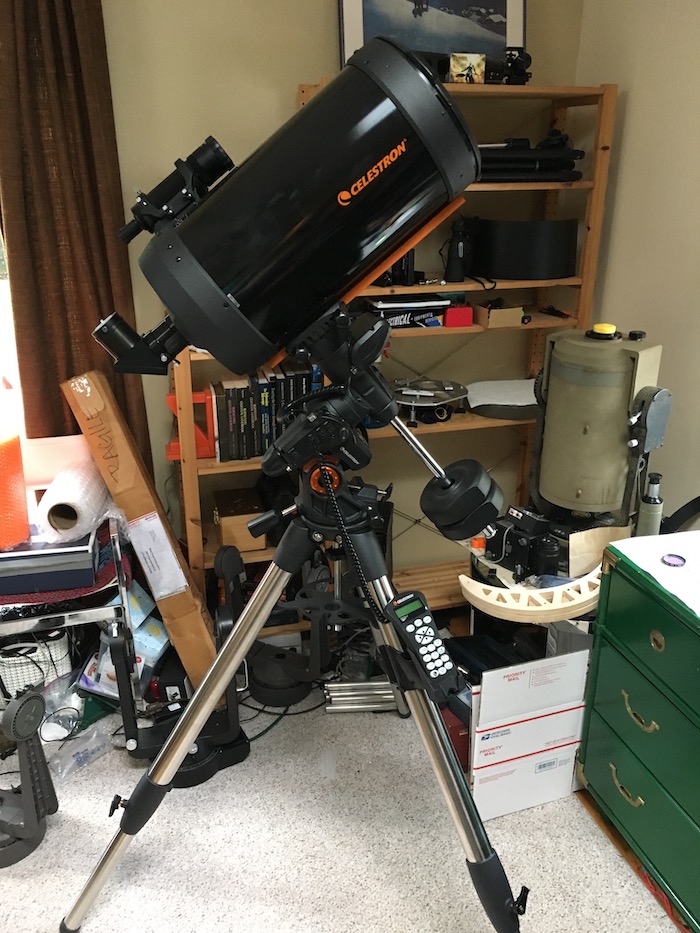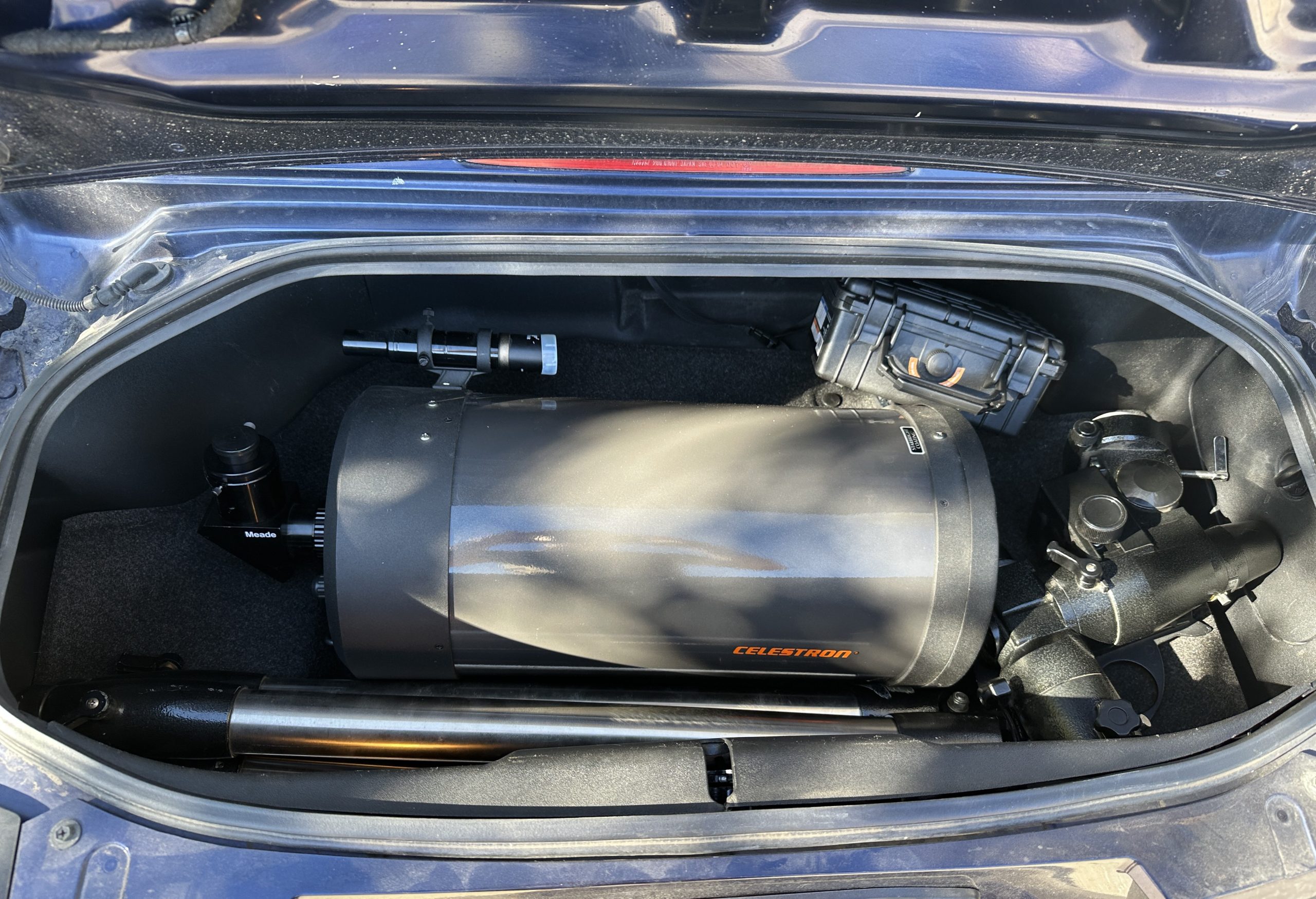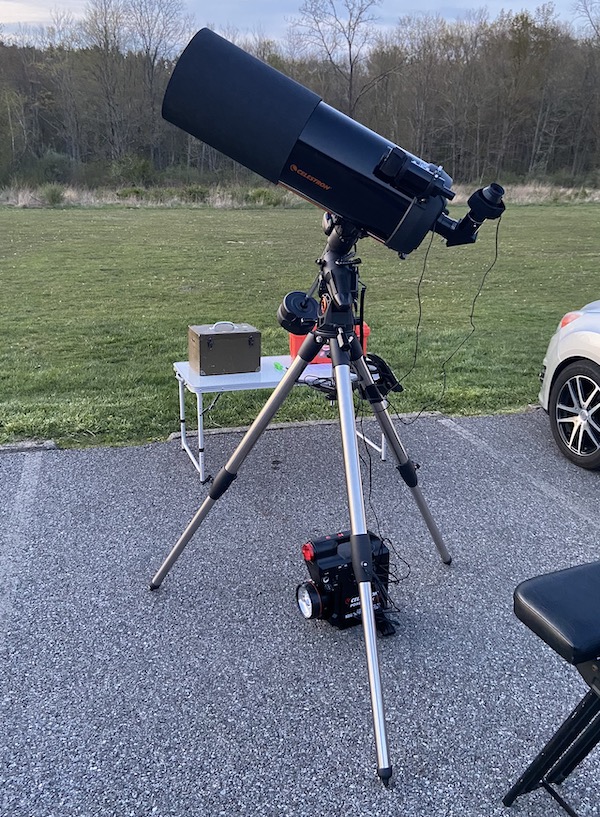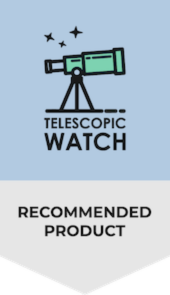The C9.25 Optical Tube
The Advanced VX 9.25” SCT (Schmidt-Cassegrain telescope) uses Celestron’s C9.25 XLT optical tube, a 9.25” (235mm) f/10 Schmidt-Cassegrain with a focal length of 2350mm. The C9.25 XLT differs from older C9.25 units by having Starizona HyperStar compatibility and slightly better coatings for increased light transmission on the mirrors and front corrector plate.
The C9.25 design uses a slower primary mirror (f/2.5 vs. f/2) compared to other Schmidt-Cassegrains offered by Celestron, and as a consequence of the slower primary mirror, the tube is a little longer in proportion than usual. The curvature of the secondary mirror is also less than usual.
The weaker curvatures of both the primary and secondary mirrors in the C9.25 mean they are easier to manufacture to high tolerance, the secondary mirror doesn’t magnify optical issues with the primary mirror as much, and collimation tolerances are more lax. As a result, the C9.25 gives me better images than would be expected for a telescope of its size, particularly a Schmidt-Cassegrain. It punches a bit above its weight, with sharpness that often exceeds that of typical 10–12″ SCTs.
As with most Schmidt-Cassegrains, I focus the C9.25 XLT by turning a knob on the back of the telescope, which moves the primary mirror back and forth inside the tube. This leads to some “image shift” when focusing, especially at high magnification or when imaging, where the target object seems to bounce around the field of view. The good news is that with most C9.25s, this issue is minimal.
The C9.25 XLT does need to be collimated from time to time by adjusting the secondary mirror. I do not recommend replacing the stock Philips head screws with thumbscrews, as thumbscrews are often not stiff and tight enough to retain collimation and are all-too-tempting to fiddle with when the collimation is good enough. Collimating SCTs is not particularly difficult or time-consuming; our collimation guide explains more.
The back of the C9.25 XLT has a standard threaded port that is made to fit Schmidt-Cassegrain adaptors and accessories. It fully illuminates the field of a “full frame” camera sensor or 2” eyepiece without any issues, something the smaller C8 and C6 XLT telescopes that I tested cannot do.
You can also use an f/6.3 focal reducer for deep-sky astrophotography or visual work with the AVX 9.25 SCT. But exceptional deep-sky astrophotography requires a beefier mount than the Advanced VX, and in the case of deep-sky visual, I’d recommend a star diagonal in place of the f/6.3 focal reducer instead. The C9.25 XLT can even be turned into a 470 mm focal length Schmidt camera by taking out the secondary mirror and installing a Starizona HyperStar f/2 conversion kit in its place.
The bottom of the C9.25 XLT tube provided with the Advanced VX uses a CGE-style dovetail, which is slightly narrower than a true Losmandy D-style dovetail. Older units used to use a Vixen-style dovetail plate. Either one will allow the telescope to be used with any mount saddle that can fit the dovetail plate.
Accessories
The Celestron Advanced VX 9.25″ SCT comes with a single eyepiece: a 25 mm, 1.25” E-Lux Plossl yielding 94x magnification.
The eyepiece has a 52-degree apparent field of view and is tack sharp with the C9.25 XLT at f/10, though you’ll want additional eyepieces for lower and higher magnifications, and a 2” diagonal and eyepieces will allow for a wider achievable true field of view.
Celestron also includes a 1.25” prism 90-degree star diagonal with an all-metal body and multi-coated prism, a 1.25” screw-on visual back for the C9.25 XLT, and a 6×30 magnifying finder scope.
The diagonal that comes with it is well-made, and it didn’t give me problems with glare or sharpness like cheap mirror or Amici prism diagonals. The provided 6×30 finder has a field of view that’s about 7 degrees across, similar to that of a pair of 7×50 binoculars, and an upside-down image with crosshairs. It works fine for the task of aligning the Advanced VX mount on a few alignment stars.
The Advanced VX Equatorial Mount

The Advanced VX mount is Celestron’s cheapest computerised German equatorial mount offering, and depending on who you ask, it’s either the sweetheart or bane of beginner astrophotographers.
It uses simple servo motors to slew around the sky and is capable of accepting autoguiders, ASCOM and CPWI drivers, and Celestron add-ons like their StarSense AutoAlign, SkySync GPS, and SkyPortal WiFi adaptor.
The servo motors in the Advanced VX, combined with some issues with the declination axis getting sticky, mean it is so-so in tracking or autoguiding accuracy and can have issues when carrying heavy telescopes. This is despite the fact that it should be able to handle up to a 6.8 kg deep-sky imaging payload (half the stated total payload capacity of 13.6 kg) without any issues. If you’re not a deep-sky astrophotographer and have no plans to ever become one, you can completely disregard these issues.
If you want to get started in deep-sky imaging by swapping the C9.25 optical tube for a small refractor or Newtonian astrograph, the Advanced VX will suffice (though another mount like the Sky-Watcher HEQ5 Pro is probably better as a dedicated imaging-only mount).
For visual or planetary imaging use, the Advanced VX can hold telescopes up to 13.6 kg. Two 5 kg counterweights are required (and provided) to balance the C9.25 XLT with enough margin for plenty of heavy accessories.
The Advanced VX can run off either AC or DC power, though only a DC cord is provided by default.
The mount accepts Vixen-style and Celestron CGE-style dovetail plates. The dovetail saddle is just a few millimetres too narrow to accept slightly wider true Losmandy D-style plates, though aftermarket dovetail saddles that do are available for a fairly reasonable price should the need arise.
Setting Up the Advanced VX 9.25 SCT
Setting up the Celestron Advanced VX 9.25 SCT is fairly simple.
After assembling the mount and installing the counterweights and telescope, I balance the telescope on both the right ascension and declination axes by sliding the tube and counterweights. After my first time doing so, I usually just put markers on the dovetail and counterweight bars to remember exactly where to place the counterweights and telescope tube for proper balance. After assembling, balancing, and levelling the telescope and mount, I do the polar alignment (there is no polar scope, but looking through the hole works fine for visual use) and then turn on the mount.
The Advanced VX uses Celestron’s same NexStar+ hand controller and software as its many other computerised telescopes. After a simple 2- or 3-star alignment procedure, the mount will automatically slew to and track over 40,000 different objects in its database. You can also plug the mount into your PC using a MicroUSB cable, which you plug into the hand controller.
With the C9.25 XLT on top of the Advanced VX, it is rock-steady, and the accuracy of its GoTo and tracking is more than enough for visual and planetary astrophotography. Any inaccuracies are probably due to poor balance or polar alignment more than anything else. The good news is that you can periodically sync the mount on new alignment stars, or simply whatever you’re currently pointing at, to improve accuracy throughout the night.

Should I buy a Used Celestron Advanced VX 9.25″ SCT?
I reckon a used, complete Advanced VX 9.25″ SCT package has a lot of complicated parts, but should one come up at a reasonable price, there’s no reason not to buy one as long as you do your due diligence.
Avoid Schmidt-Cassegrain telescopes with broken front corrector plates. These cannot be repaired or replaced without replacing all of the optics, which often costs more than a used C9.25 XLT optical tube is even worth.
A dead mount can be replaced, though you should, of course, be paying less if the mount doesn’t function.
Check to make sure that the mirrors in the C9.25 are free of corrosion and the corrector is free of fungus (which can etch the glass and permanently damage it).
Missing accessories are not a big deal; the ones provided by default are not particularly expensive to replace.
Aftermarket Accessory Recommendations
The Celestron Advanced VX 9.25” SCT package is expensive enough that you’re likely to have a sky-high budget for additional accessories.
A 2” diagonal is, regardless, a must-have; a dielectric mirror unit like the Apertura model screws directly onto the back of the C9.25 XLT.
The stock 25mm E-Lux Plossl works fine as-is, but a wide-angle, 2” low-power eyepiece; at least one medium-power eyepiece in the 14-18mm range, like the Explore Scientific 14mm 82-degree (168x); and a high-power eyepiece in the 6-12mm range, such as the Explore Scientific 8.5mm 82-degree (276x), would be the minimum kit I’d recommend. However, these are just recommendations. The C9.25 XLT works just fine with cheap Plossl and wide-angle designs like SuperView and goldline/redline oculars and can handle up to 500x magnification with perfect seeing conditions; realistically 300x is the usual upper bound even on nights of good seeing, which can be rare.
As usual, I also recommend a UHC nebula filter, preferably in a 2” size format that will screw onto a 1.25” adaptor for use with either size eyepiece.
A dew shield is an absolute must for the C9.25 XLT. The thin Schmidt corrector plate cools down extremely quickly and will quickly attract dew in even a fairly dry environment, especially if you are set up for more than an hour or two. The dew shield also stops bugs and stray light from getting into your telescope and keeps people from touching the front corrector plate by accident. An unheated dew shield is fine for most users; those in especially humid climates might want a heated dew shield, which requires a dew heater controller to match. Dew heaters for your eyepiece and finder scope are probably also warranted in this situation and will plug into the same controller.
On the mount end, the Advanced VX doesn’t come with a polar scope by default, and rough polar alignment with just the hole in the polar axis is both inaccurate and annoying, especially when your telescope veers off-course as a result. The stock polar scope sold by Celestron is just fine to solve this problem; if you do a lot of imaging, a PoleMaster and adaptor might be worth it.
Some sort of DC power supply is also required, both for your mount and dew heaters. Our top picks would be either the Celestron PowerTank Lithium standard or Pro, which also attach to your tripod legs; budget-minded users might want to just get a TalentCell or similar generic battery and zip-tie or tape it to the tripod legs.
What can you see with the Celestron Advanced VX 9.25″ SCT?
The C9.25 XLT optical tube has enough light-gathering power to pack a serious punch on deep-sky objects. Open star clusters are visible through the C9.25 regardless of your light pollution conditions on account of their brightness—though larger ones, like the Double Cluster, the Pleiades (M45), or the Beehive (M44), are unable to fit in the C9.25’s narrow field of view, while smaller clusters like M35, M11, M46, and M38 still delight. Globular star clusters like M3 and M22 can be resolved all the way to their centres with the C9.25 using high magnification and exhibit different morphology, like M13’s dust lanes, M15’s tight core, M4’s looser structure, or M92’s out-of-round shape. Dimmer globular clusters remain unresolved, however, or are simply invisible under more light-polluted skies.
The C9.25 also has enough light-gathering ability to show you plenty of planetary nebulae, and the Advanced VX mount will have no trouble bringing you right to them. The Cat’s Eye shows its greenish colour, and you can of course see the hues of the aptly-named Blue Snowball or the turquoise Blinking Planetary Nebula with its white dwarf progenitor star at the centre. The more well-known Ring (M57) and Dumbbell (M27) can also be seen.
Galaxies and large nebulae are more affected by light pollution, but the C9.25 will be able to show you the gaseous clouds of Orion (M42) and the Lagoon (M8) even under fairly bright skies; dark skies and/or a UHC filter bring out more detail and will allow you to go after other nebulae like the Trifid (M20) and Swan (M17). The C9.25’s focal length is too long to allow you to take in much of the Veil Nebula at a time, but you can still see it with dark skies and a good UHC filter. A filter doesn’t help with galaxies, and under light-polluted skies, few are visible, and those that are lack detail. But under dark skies, the C9.25 can show you thousands of galaxies, including hundreds in the Virgo Cluster, the dust lanes in galaxies like M64, M104, M31, and M82, and hints of spiral arms in M51 and M33 if you are patient.
The C9.25 is, of course, also a powerhouse on planets. The phases of Venus and Mercury are, of course, easy to see. The Moon looks fantastic, with details just miles wide visible on a night of good seeing and thousands of mountains, craters, and ridges dazzling the viewer regardless of phase or poor seeing. Mars shows its polar ice cap, and when it’s close to Earth and seeing conditions are favourable, the C9.25 reveals dark markings on its surface. Jupiter’s Great Red Spot and various colourful cloud bands are visible, and its moons are resolved clearly when they transit in front of the planet, along with their jet-black shadows following close behind.
The C9.25 will of course show you the rings of Saturn, along with the Cassini Division on a suitably steady night, and perhaps even the Encke gap in the rings to scrutinising observers. Saturn also features some dull cloud bands and around half a dozen moons. You’ll also be able to resolve Uranus’ teal disk and possibly spot one or two of its moons, whereas Neptune is more difficult to distinguish from a star, but its moon Triton is easier to spot than Uranus’. Pluto is just barely within the grasp of the C9.25 under dark skies owing to its limited aperture, though it can be seen as a star-like point if you know where to look.
Astrophotography Capabilities
The C9.25 XLT is simply too heavy and too long in focal length for the Advanced VX to handle for deep-sky imaging, even with autoguiding and if reduced to f/6.3 and 1480 mm focal length. The C9.25 on a bigger mount is a nightmare to reckon with as a first-time deep-sky astrophotography rig or even for experienced imagers. The C9.25 XLT is capable of accepting Starizona’s HyperStar f/2 conversion kit, reducing it to a 470mm focal length, which should increase tolerances, but even at f/2, the Advanced VX is simply under too much strain with an autoguider, guide scope, and camera attached to the already-heavy C9.25.
On the other hand, planetary astrophotography is well within the grasp of the Advanced VX 9.25″ SCT package due to the much less demanding tracking requirements. A good Barlow lens and high-speed planetary video camera, coupled to a laptop and free capture software, are all you need to get fabulous shots of the Moon, Mars, Jupiter, and Saturn.



